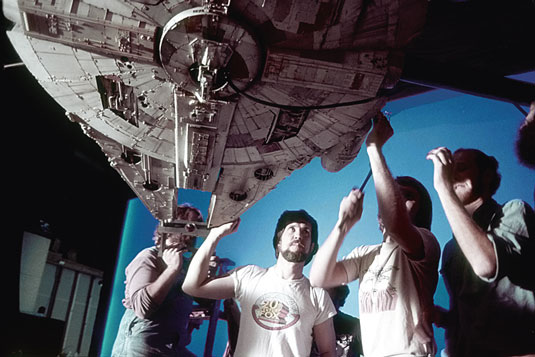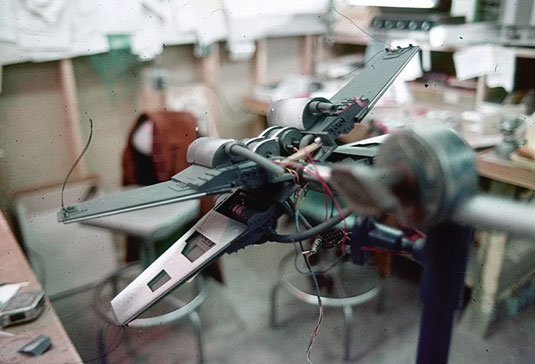The secrets behind Star Wars' special effects
It was the movie that changed everything. But Star Wars was made on an X-wing and a prayer, reveals Oscar-winning Richard Edlund

The iconic work in Star Wars would not have been possible without the geniuses who navigated the technology needed to create the film. One of those geniuses is Richard Edlund.
Considering three of his four Oscars were for VFX in the first three Star War films, and he's since added a bevy of awards and nominations including three Academy Scientific and Engineering Awards, it's difficult to imagine his career began with such humble beginnings.
Even more astounding, the innovations on Star Wars: Episode IV – A New Hope launched an entire industry on what would now be the budget of a 60-second commercial. "I think the effects budget on Star Wars was $2.5 million. It was like no money," says Edlund.
Building a reputation

Nothing gets done without credibility, and in Hollywood, it's one of the hardest things to establish. "So there we were," says Edlund, "a bunch of ex-hippies – longish haired guys. I don't even know if I was smoking pot any more at that time.
"We all had great commercial reels; John [Dykstra] had worked on Silent Running and I had worked on the Star Trek television show and various movies. I set up Al Whitlock's first matte shot for a movie that never went anywhere, called The Glory Guys. But we didn't have any feature effects. Fox was really paranoid about us because we were spending money and they had no understanding of what the hell we were doing."
2000-1 shot
Early on Edlund called on Jerry Smith, a business agent at the local camera union, 659. "I told him I was going to take a job as first cameraman on this big sci-fi movie that Fox was doing called Star Wars. Being a punster, he said, ‘You know, the odds are about two thousand to one that I don't have a guy that can fill that job.'"
The union sent out a couple of cameramen but the demands of the Star Wars filming process was so unique "they had no idea what we were doing," says Edlund.
Daily design news, reviews, how-tos and more, as picked by the editors.

About six months later some union members paid a visit, including one from the props, some teamsters and Josef Bernay. The timing was good as the team had just finished building the system that would give more visual detail and greater depth of field.
"We had finished building the VistaVision motion control camera on its boom and we were just starting to run tests. I knew they were coming," says Edlund, "so I positioned them for a demonstration.
"I had pre-programmed the elaborate camera to go down to the end of the track and stop, the boom to rise up and swing around towards the camera, then to travel right up to within a few feet of the union guys and stop."
Like magic
"They didn't know what to say, this was like magic. Where's the operator, where's the loader? So they left. And about three weeks later I was accepted into the local as a director of photography." It was the cameraman's version of 'make it shiny.'
There was a second instance involving Lin (Linwood) Dunn, who was the patriarch of special photographic effects (now known as visual effects). "The studio was paranoid about this bunch of unknowns, so they sent in Lin and his sidekick, Cecil Love. John Dykstra and I were showing him the equipment, and John was evangelising about motion control.

"Cecil goes around to the back of the tower to look at the electronics. He opens it up and it has all these wires, like barbershop sweepings, electronic spaghetti. He looks at it, looks at John, sets his jaw. He was real stoic and has nothing to say at all. John was really worried that we weren't impressing them."
The meeting did result in some very good advice. "Lin took me aside and said, ‘Look, I think you guys have your act together but one thing you've got to worry about is keeping track of all those elements. That is going to be your big problem.'
That was really good advice so we wound up hiring [production staffer] Rose Duignan, [production coordinator] Mary Lind and a few other people. I was thinking, "let's call the Rand Corporation!"
Next page: more secrets of the making of Star Wars...

The Creative Bloq team is made up of a group of art and design enthusiasts, and has changed and evolved since Creative Bloq began back in 2012. The current website team consists of eight full-time members of staff: Editor Georgia Coggan, Deputy Editor Rosie Hilder, Ecommerce Editor Beren Neale, Senior News Editor Daniel Piper, Editor, Digital Art and 3D Ian Dean, Tech Reviews Editor Erlingur Einarsson, Ecommerce Writer Beth Nicholls and Staff Writer Natalie Fear, as well as a roster of freelancers from around the world. The ImagineFX magazine team also pitch in, ensuring that content from leading digital art publication ImagineFX is represented on Creative Bloq.
